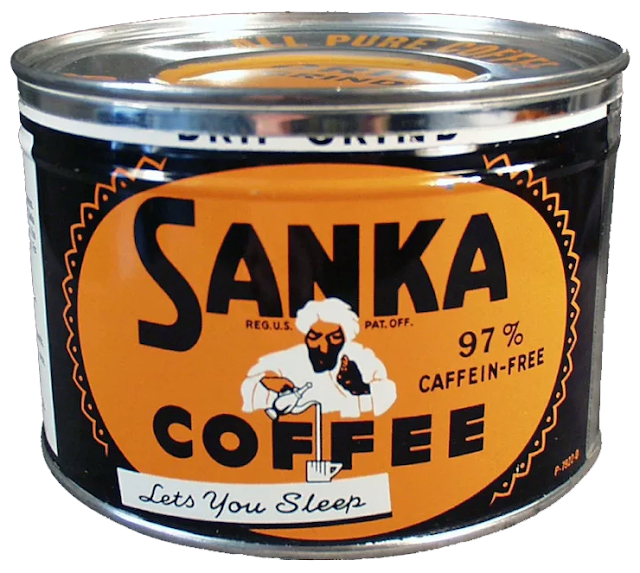Associating the color orange with decaf coffee goes all the way back to one of the original makers, Sanka.
Decaffeinated coffee was developed in 1903 by a team of researchers led by Ludwig Roselius in Bremen, Germany. It was first sold in Germany and many other European countries in 1905–1906 under Kaffee HAG (short for Kaffee Handels-Aktien-Gesellschaft, or Coffee Trading Public Company). The brand name became Sanka in France, derived from the French words sans caféine ("without caffeine"). The brand came to the United States in 1909–1910, where it was first marketed under the name "Dekafa" or "Dekofa" by an American sales agent.
Though his decaf had made its way to America in 1909, Roselius began selling it under the Kaffee Hag Corporation name in 1914, the start of World War I. It's safe to say that Americans and Germans weren't exactly friendly with each other at the time. In fact, Roselius had his American company, along with all its trademarks were, confiscated from him by the Alien Property Custodian, an entity created in 1917 by the US government to "assume control and dispose of enemy-owned property in the United States and its possessions."
 |
| 1914 American newspaper ad for Kaffee HAG |
In Europe, the Hag company used the Sanka brand name in many countries (The Netherlands, Belgium, Germany, Switzerland, amongst others) as a cheaper alternative to the premium brand of Coffee Hag. The brand disappeared in these countries after World War II, but it continued until the 1970s as the premium brand in France.
When Roselius wanted to reestablish a decaffeinated coffee brand in America, he did so under the moniker Sanka in 1923. Sanka was initially sold at only two Sanka Coffee Houses in New York City, but it soon was brought into retail.
Then in 1932, Sanka was sold to General Foods, which began an aggressive marketing program to promote their newest product.
 |
| A Kaffee Hag Coffee can; ground coffee, 97% caffeine-free, processed and packed at the Maxwell House Coffee plant in Hoboken, New Jersey. 1940-1950 |
General Foods began by sending coffee shops and restaurants nationwide new coffee pots in the color of Sanka's eye-catching packaging: orange. What was first a way of saying, "We Sell Sanka," became an easily-recognizable way to distinguish all decaffeinated coffee from its leaded counterpart.
 |
| 1932 Advertisement |
Since then, Sanka has lost a bit of favor in the coffee world, and it is still widely distributed by Kraft Foods but isn't quite the ubiquitous coffee shop, restaurant, and pantry staple for the decaf-inclined. Indeed, decaf coffee is enjoying a new level of appreciation by coffee lovers worldwide, resulting in a pleasurable surfeit of excellent decaf options and even an ongoing boom of roasters that specialize in decaf.
The orange-colored coffee pot lids are a staple in every restaurant and coffee house in America. Decaf coffee has never been better, but even today, it stands on the orange shoulders of the originator, Sanka.
Compiled by Dr. Neil Gale, Ph.D.






No comments:
Post a Comment